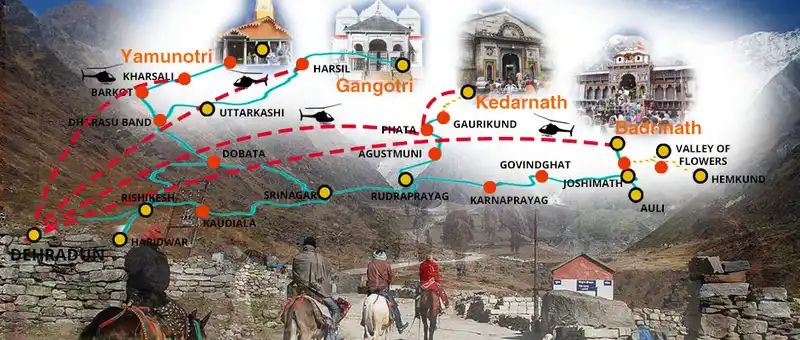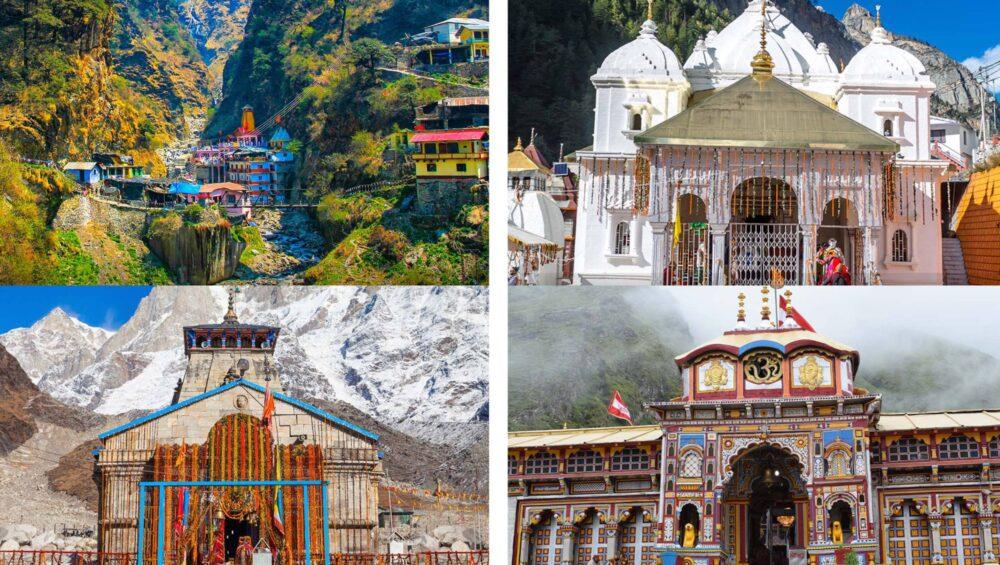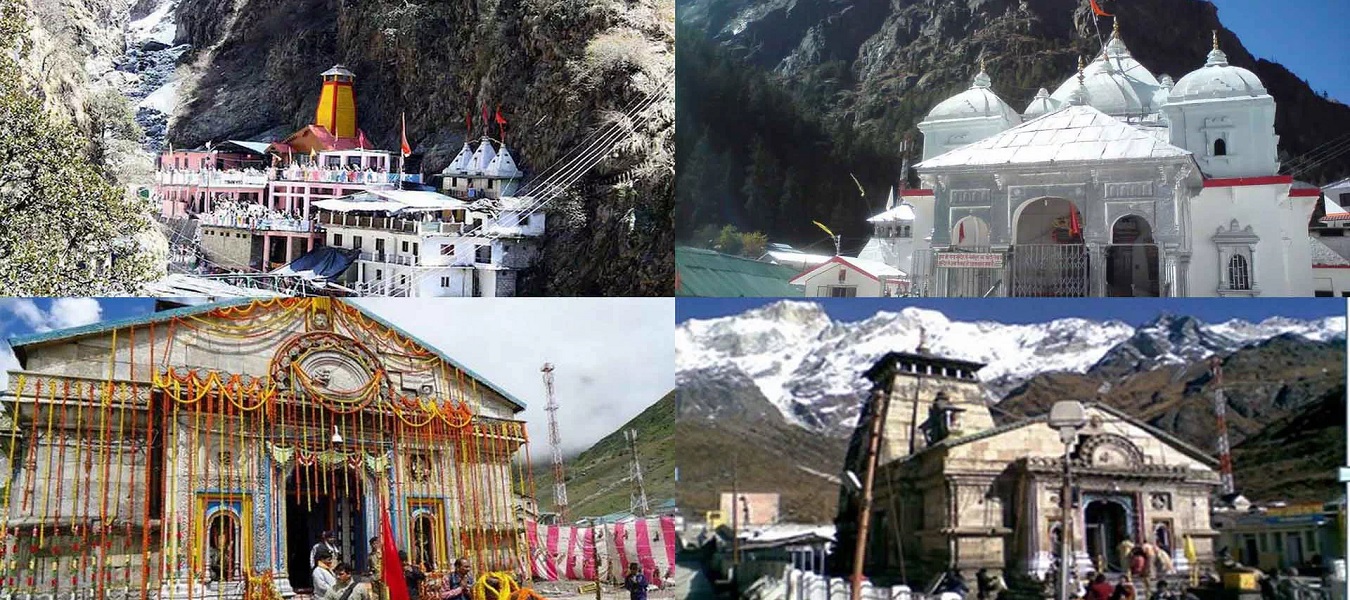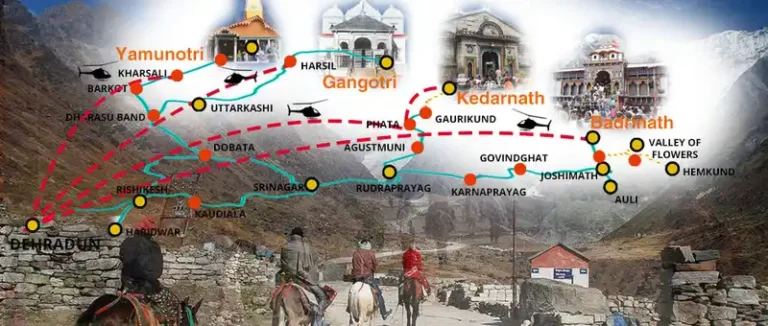Best time to visit Chardham

The best time to visit the Chardham, which refers to the four holy pilgrimage sites in Uttarakhand, India (Badrinath, Kedarnath, Gangotri, and Yamunotri), largely depends on the specific site you plan to visit. Here are the ideal times to visit each of the Chardham destinations:
Best time to visit Chardham in Summer Season (May to June):

Here’s more information about the first point regarding the best time to visit Chardham during the summer season (May to June):
Pleasant Weather: During the summer months, the weather in the Chardham region is generally pleasant and favorable for pilgrimage. The temperatures range from around 10°C to 25°C (50°F to 77°F), offering a comfortable and enjoyable experience for visitors.
Accessibility: The summer season is ideal for visiting Chardham as the roads leading to the pilgrimage sites are mostly open and accessible. This allows for smoother travel and reduces the chances of road blockages due to landslides or heavy snowfall.
Vibrant Atmosphere: The summer season is considered the peak pilgrimage season, attracting a large number of devotees from all over the country. The pilgrimage sites, such as Badrinath, Kedarnath, Gangotri, and Yamunotri, are filled with devotees engaging in prayers, religious rituals, and festivities, creating a vibrant and energetic atmosphere.
Sightseeing Opportunities: Apart from the spiritual significance, the Chardham region is renowned for its breathtaking natural beauty. During the summer season, the landscapes are lush and green, adorned with blooming flowers and meandering rivers. This provides visitors with excellent opportunities for sightseeing, nature walks, and exploring the scenic surroundings.
Longer Days: Another advantage of visiting Chardham during the summer season is the longer days. The extended daylight hours allow visitors to have more time to explore and soak in the beauty of the pilgrimage sites and their surroundings.
Accommodation Availability: During the summer season, the availability of accommodation options in and around the Chardham sites is relatively higher compared to other seasons. It is advisable to make advance reservations to secure a comfortable stay during your pilgrimage.
Remember to pack appropriate clothing for varying temperatures, carry necessary essentials such as sunscreen, hats, and comfortable walking shoes. It is also advisable to carry some rain gear as brief showers can occur during this season.
Please note that the specific opening and closing dates for each Chardham site may vary each year, so it’s recommended to check the official announcements and plan your visit accordingly.
Best time to visit Chardham in Monsoon Season (July to September):

The monsoon season (July to September) is not considered the best time to visit Chardham due to the heavy rainfall and associated challenges. However, if you still plan to visit during this season, here are some important considerations:
Weather Conditions: The monsoon season brings heavy rainfall to the Chardham region, which can lead to landslides and flash floods. The weather can be unpredictable, and there is an increased risk of road blockages and disrupted transportation.
Safety Concerns: The heavy rainfall and associated hazards make it unsafe to travel and visit the Chardham sites during the monsoon season. Landslides and flooding can pose risks to travelers, and the conditions may make it difficult to access the pilgrimage sites.
Limited Accessibility: Due to the challenging weather conditions, road access to the Chardham sites may be restricted or completely blocked at times. This can significantly hinder your travel plans and make it difficult to reach the pilgrimage sites.
Reduced Pilgrimage Activity: The number of pilgrims visiting Chardham during the monsoon season is considerably lower compared to other times of the year. The pilgrimage sites may have limited facilities and services available during this period.
Precautions and Flexibility: If you still decide to visit Chardham during the monsoon season, it is crucial to take necessary precautions. Stay updated with weather forecasts and road conditions, and be prepared for potential delays and itinerary changes. Carry appropriate rain gear, sturdy footwear, and necessary medications.
Temple Closure: It is common for the Chardham temples, such as Badrinath, Kedarnath, Gangotri, and Yamunotri, to remain closed during the monsoon season due to safety concerns and inaccessibility. Therefore, it is advisable to check the official temple websites or consult with local authorities to confirm the opening and closing dates before planning your visit.
It is generally recommended to avoid visiting Chardham during the monsoon season and plan your pilgrimage during the more favorable seasons of summer or autumn when the weather conditions are more conducive for travel and exploration.
Best time to visit Chardham in Autumn Season (October to November):

The autumn season (October to November) is considered one of the best times to visit Chardham. Here’s why:
Pleasant Weather: During the autumn season, the weather in the Chardham region is generally pleasant and mild. The temperatures range from around 5°C to 20°C (41°F to 68°F), providing a comfortable and enjoyable experience for pilgrims.
Clear Skies: Autumn is characterized by clear skies and reduced chances of rainfall. This means better visibility of the stunning landscapes, mountains, and rivers surrounding the Chardham sites. The pleasant weather conditions create an ideal atmosphere for spiritual exploration and sightseeing.
Lower Crowds: Compared to the summer season, the autumn season experiences fewer crowds and a more serene environment. This allows for a more peaceful and tranquil pilgrimage experience, as you can explore the sacred sites with less rush and enjoy a deeper connection with the spirituality of the region.
Festivals and Celebrations: The autumn season is also marked by several significant Hindu festivals, such as Diwali and Dussehra. This adds a festive charm to the Chardham pilgrimage, with the temples adorned with decorations, lights, and special rituals. It’s a wonderful time to witness and participate in the cultural festivities associated with these festivals.
Scenic Beauty: The autumn season showcases the picturesque beauty of the Chardham region. The landscapes are painted in vibrant hues of orange, yellow, and red as the leaves of the trees change color. The combination of the natural beauty and the spiritual significance of the pilgrimage sites creates a truly enchanting experience.
Accessibility: The roads leading to the Chardham sites are generally in good condition during the autumn season. This ensures smoother travel and easier access to the pilgrimage sites without major disruptions.
However, it’s important to note that the autumn season is also the shoulder season, which means there might be some variability in weather conditions. It’s recommended to check the local weather forecasts and plan your visit accordingly. Additionally, it’s advisable to make accommodation and travel arrangements in advance, as availability may be limited during this time.
Overall, the autumn season offers a perfect blend of favorable weather, reduced crowds, cultural celebrations, and scenic beauty, making it an ideal time to embark on the Chardham pilgrimage
Best time to visit Chardham in Winter Season (December to April):

The winter season (December to April) is not considered the best time to visit Chardham due to harsh weather conditions and limited accessibility. However, here are some important details if you still plan to visit during this season:
Extreme Cold: The Chardham region experiences extremely cold temperatures during winter, with temperatures often dropping below freezing point. The temperatures can range from -5°C to 10°C (23°F to 50°F) or even lower in higher altitudes. It is essential to be well-prepared for freezing temperatures and harsh weather conditions.
Heavy Snowfall: The winter season brings heavy snowfall to the Chardham region, especially in higher elevations. The roads leading to the pilgrimage sites are often blocked due to snow, making it difficult or impossible to reach the temples.
Limited Accessibility: The Chardham pilgrimage sites, including Badrinath, Kedarnath, Gangotri, and Yamunotri, are usually closed during the winter season. The temples remain inaccessible due to heavy snowfall and unsafe travel conditions. The region becomes isolated and challenging for pilgrimage activities.
Winter Trekking: Despite the closures of the Chardham temples, some adventurous trekkers and devotees may choose to undertake winter treks to certain sites, such as Kedarnath. These treks require specialized equipment, mountaineering experience, and should only be attempted by experienced individuals who are well-prepared for extreme winter conditions.
Limited Facilities: During the winter season, the infrastructure and facilities around the Chardham sites are limited. Many hotels, guesthouses, and other services may be closed due to the low influx of tourists. It is crucial to check for accommodation availability in advance and ensure that basic amenities are accessible during your visit.
Safety Concerns: The winter season in the Chardham region poses several safety concerns due to extreme cold, heavy snowfall, and icy conditions. It is essential to prioritize safety and follow all necessary precautions if you decide to visit during this season.
Considering the challenging weather conditions, limited accessibility, and closure of the temples, it is generally recommended to avoid visiting Chardham during the winter season. Instead, it is advisable to plan your pilgrimage during the more favorable seasons of summer, autumn, or spring, when the weather is milder, and the pilgrimage sites are accessible to visitors
It’s important to note that the opening and closing dates of the Chardham pilgrimage sites may vary each year, as they are determined based on the Hindu calendar and announced by the respective temple authorities. It is advisable to check the official announcements and plan your visit accordingly.
Additionally, it’s recommended to check the weather forecasts and road conditions before traveling to Chardham, as the region is prone to sudden weather changes and road blockages, particularly during the monsoon season and winter months.


